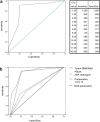Preoperative circulating tumor cells to predict microvascular invasion and dynamical detection indicate the prognosis of hepatocellular carcinoma
- PMID: 33129301
- PMCID: PMC7603758
- DOI: 10.1186/s12885-020-07488-8
Preoperative circulating tumor cells to predict microvascular invasion and dynamical detection indicate the prognosis of hepatocellular carcinoma
Abstract
Background: This study explored the diagnostic power of preoperative circulating tumor cells (CTCs) for the presence of microvascular invasion (MVI) and the relationship between dynamic changes in postoperative CTCs and prognosis.
Methods: A total of 137 patients were recruited for the study. Preoperative blood samples were collected from all patients to detect CTCs. The time points for blood collection were before the operation, during the operation, and at 1 week, 1 month, 2 months, 3 months, 6 months, and 1 year after surgery. The predictive power of CTC count for the presence of MVI was analyzed by receiver operating characteristic (ROC) curve analysis. According to recurrence status, 137 patients were divided into three groups: no recurrence, early recurrence, and non-early recurrence groups.
Results: A threshold CTC count of 5 showed the most significant power for predicting the existence of MVI. In multivariate analysis, the parameters of preoperative CTC count, alpha-fetoprotein (AFP) and tumor diameter were independent predictors of MVI (P < 0.05). A CTC count greater than or equal to 5 had better predictive value than AFP > 400 μg/L and tumor diameter > 5 cm. The number of intraoperative CTCs in the three groups did not increase compared to that before surgery (P > 0.05). The number of CTCs in the nonrecurrence group and the non-early recurrence group decreased significantly 1 week after surgery compared with the intraoperative values (P < 0.001), although there was no significant difference in the early recurrence group (P = 0.95). Patients with mean CTC count ≥5 had significantly worse long-term outcomes than those with mean CTC count < 5 (P < 0.001).
Conclusion: The preoperative CTC counts in the peripheral blood of patients with HCC are closely correlated with MVI. The intraoperative manipulation of the lesion by the surgeon does not increase the number of CTCs in peripheral blood. Surgical removal of the tumor decreases the number of CTCs. The persistence of CTCs at a high level (≥ 5) after surgery suggests a risk of early recurrence.
Clinical trial registration: Registration number is ChiCTR-OOC-16010183 , date of registration is 2016-12-18.
Keywords: Circulating tumor cells; Extrahepatic metastasis; Hepatectomy; Hepatocellular carcinoma; Isolation by size of epithelial tumor cells; Microvascular invasion.
Conflict of interest statement
The authors declare that they have no competing interests.
Figures




References
Publication types
MeSH terms
Grants and funding
LinkOut - more resources
Full Text Sources
Other Literature Sources
Medical

